| Style |
Sample
fly |
Use/purpose |
"bead
head"
(or, BH) |
 |
"bead heads"
use a brass or copper bead slipped over the eye of the fly; it adds weight to help
sink the fly & also adds a bit of "flash" to assist in
attracting fish |
| Golden
Stone beadhead nymph |
| "cone
head" |
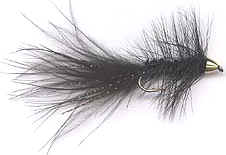 |
similar to bead head
style, but uses a cone-shaped metal "hood" over the hook eye;
generally on larger flies requiring more weight to sink |
| Conehead
Wooly Buggar |
| "extended
body" |
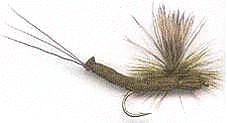 |
used
on both dry and streamer patterns; exhibits an elongated body or tail end
which extends beyond the bend of the hook |
| Green
Drake (mayfly adult) |
| "parachute
fly" |
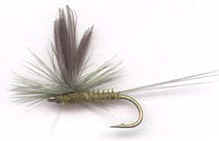 |
uses
a hackle wound around upright wings (or stem) on top of the fly in a
horizontal, parallel-to-the-hook-shank fashion
(rather than conventional perpendicular); designed to allow the fly to sit
"in" the water, rather than "on" it |
| Blue
Winged Olive parachute |
"tunghead"
(or, TH) |
 |
same
as a "bead head" style, but using tungsten as the metal in the bead
over the eye of the fly; usually a bit heavier than brass, hence more sinking power |
| Green
Weenie (caddis pupa) |
| "CDC" |
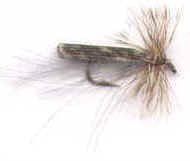 |
refers
to a fly tied with "CDC" (Cul de Canard) fibers in the wings,
hackle, body or tail of the fly; (cdc is a fluffy bird feather with water repellent
qualities) |
| CDC
Caddis |
| "popper" |
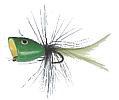 |
a
variety of floating flies that suggest a live, surface animal, such as a
frog; derived from the "popping" sound the fly makes when action
is imparted to it by the fly fisher; may be made of cork, plastic, foam,
deer hair, etc. |
| Frog
Popper |
| "keel
flies" |
 |
these
are flies that are tied "upside down" with the hook point riding
up, rather than down; primarily used when imitating bottom dwelling
species to avoid the hookpoint digging into the bottom |
| Clouser
Minnow |
| "trude
flies" |
 |
this
style uses an overly long, thick calf hair wing swept back at a 45 degree angle
to the hook shank & heavy hackle; it is used on dry flies to give them
more buoyancy |
| Royal
Trude |
| "wulff
flies" |
 |
a
style of flies named for the originator, famous fly angler, Lee Wulff; features heavy "overdressed" tail,
hackle and calf tail wings; made as an attractor pattern to float high,
last long |
| Royal
Wulff |
| "no
hackle" |
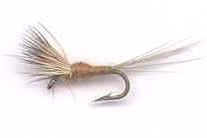 |
these
dry flies are tied without any hackle around the shank; they are designed
so that the fly, usually representing an adult mayfly spinner, rests just
"in" the surface film (as opposed to on it) |
| Pale
Evening Dun Spinner |
| "palmered" |
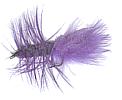 |
palmered
flies (like this Wooly Bugger) are those tied with hackle feather(s) spiraled
down the length of the fly so that the fibers flair out from the hook shank;
this gives the fly a lot of action/motion in the water; generally used in
sinking patterns. |
| Wooly
Bugger tied palmered style |











